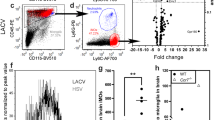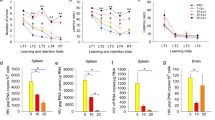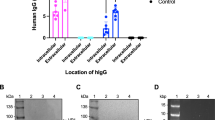Abstract
The CCR5 chemokine receptor is important for most clinical strains of HIV to establish infection. Individuals with naturally occurring polymorphisms in the CCR5 gene who have reduced or absent CCR5 are apparently otherwise healthy, but are resistant to HIV infection. With the goal of reducing CCR5 and protecting CCR5+ cells from R5-tropic HIV, we used Tag-deleted SV40-derived vectors to deliver several anti-CCR5 transgenes: 2C7, a single-chain Fv (SFv) antibody; VCKA1, a hammerhead ribozyme; and two natural CCR5 ligands, MIP-1α and MIP-1β, modified to direct these chemokines, and hence their receptor to the endoplasmic reticulum. These transgenes were delivered using recombinant, Tag-deleted SV40-derived vectors to human CCR5+ cell lines and primary cells: monocyte-derived macrophages and brain microglia. All transgenes except MIP-1α decreased CCR5, as assayed by immunostaining, Northern blotting, and cytofluorimetry (FACS). Individually, all transgenes except MIP-1α protected from low challenge doses of HIV. At higher dose HIV challenges, protection provided by all transgenes diminished, the SFv and the ribozyme being most potent. Vectors carrying these two transgenes were used sequentially to deliver combination anti-CCR5 genetic therapy. This approach gave approximately additive reduction in CCR5, as measured by FACS and protected from higher dose HIV challenges. Reducing cell membrane CCR5 using anti-CCR5 transgenes, alone or in combinations, may therefore provide a degree of protection from R5-tropic strains of HIV.
This is a preview of subscription content, access via your institution
Access options
Subscribe to this journal
Receive 12 print issues and online access
$259.00 per year
only $21.58 per issue
Buy this article
- Purchase on Springer Link
- Instant access to full article PDF
Prices may be subject to local taxes which are calculated during checkout









Similar content being viewed by others
References
Berger EA, Murphy PM, Farber JM . Chemokine receptors as HIV-1 coreceptors: roles in viral entry, tropism, disease. Annu Rev Immunol 1999; 17: 657–700.
Collman RG, Yi Y . Cofactors for human immunodeficiency virus entry into primary macrophages. J Infect Dis 1999; 179: S422–S426.
Liu R et al. Homozygous defect in HIV-1 coreceptor accounts for resistance of some multiply-exposed individuals to HIV-1 infection. Cell 1996; 86: 367–377.
Samson M et al. Resistance to HIV-1 infection in caucasian individuals bearing mutant alleles of the CCR-5 chemokine receptor gene. Nature 1996; 382: 722–725.
Dean M et al. Genetic restriction of HIV-1 infection, progression to AIDS by a deletion allele of the CKR5 structural gene. Hemophilia Growth, Development Study, Multicenter AIDS Cohort Study, Multicenter Hemophilia Cohort Study, San Francisco City Cohort, ALIVE Study. Science 1996; 273: 1856–1862.
Huang Y et al. The role of a mutant CCR5 allele in HIV-1 transmission, disease progression. Nat Med 1996; 2: 1240–1243.
Eugen-Olsen J et al. Heterozygosity for a deletion in the CKR-5 gene leads to prolonged AIDS-free survival, slower CD4 T-cell decline in a cohort of HIV-seropositive individuals. Aids 1997; 11: 305–310.
O'Brien TR et al. 2nd HIV-1 infection in a man homozygous for CCR5 delta 32. Lancet 1997; 349: 1219.
Theodorou I et al. HIV-1 infection in an individual homozygous for CCR5 delta 32. Seroco Study Group. Lancet 1997; 349: 1219–1220.
Quillent C et al. HIV-1-resistance phenotype conferred by combination of two separate inherited mutations of CCR5 gene. Lancet 1998; 351: 14–18.
Kupfer B et al. Protection against parenteral HIV-1 infection by homozygous deletion in the C-C chemokine receptor 5 gene. Aids 1999; 13: 1025–1028.
Ometto L et al. Restriction of HIV type 1 infection in macrophages heterozygous for a deletion in the CC-chemokine receptor 5 gene. AIDS Res Hum Retroviruses 1999; 15: 1441–1452.
Ward SG, Bacon K, Westwick J . Chemokines, T lymphocytes: more than an attraction. Immunity 1998; 9: 1–11.
Ward SG, Westwick J . Chemokines: understanding their role in T-lymphocyte biology. Biochem J 1998; 333: 457–470.
Cagnon L, Rossi JJ . Downregulation of the CCR5 beta-chemokine receptor, inhibition of HIV-1 infection by stable VA1-ribozyme chimeric transcripts. Antisense Nucleic Acid Drug Dev 2000; 10: 251–261.
Feng Y et al. Inhibition of CCR5-dependent HIV-1 infection by hairpin ribozyme gene therapy against CC-chemokine receptor 5. Virology 2000; 276: 271–278.
Rossi JJ, Sarver N . RNA enzymes (ribozymes) as antiviral therapeutic agents. Trends Biotechnol 1990; 8: 179–183.
Rossi JJ et al. Ribozymes as therapies for AIDS. Ann NY Acad Sci 1990; 616: 184–200.
Sarver N et al. Ribozymes as potential anti-HIV-1 therapeutic agents. Science 1990; 247: 1222–1225.
Steinberger P et al. Functional deletion of the CCR5 receptor by intracellular immunization produces cells that are refractory to CCR5-dependent HIV-1 infection and cell fusion. Proc Natl Acad Sci USA 2000; 97: 805–810.
Königs C et al. Monoclonal antibody screening of a phage-displayed random peptide library reveals mimotopes of chemokine receptor CCR5: implications for the tertiary structure of the receptor and for an N-terminal binding site for HIV-1 gp120. Eur J Immunol 2000; 30: 1162–1171.
Chen JD et al. Inactivation of HIV-1 chemokine co-receptor CXCR-4 by a novel intrakine strategy. Nat Med 1997; 3: 1110–1116.
Strayer DS, Milano J . SV40 mediates stable gene transfer in vivo. Gene Therapy 1996; 3: 581–587.
Strayer DS . SV40 as an effective gene transfer vector in vivo. J Biol Chem 1996; 271: 24741–24746.
Strayer DS, Kondo R, Milano J, Duan LX . Use of SV40-based vectors to transduce foreign genes to normal human peripheral blood mononuclear cells. Gene Therapy 1997; 4: 219–225.
Strayer DS, Zern MA . Gene delivery to the liver using simian virus 40-derived vectors. Semin Liver Dis 1999; 19: 71–81.
Strayer DS . Effective gene transfer using viral vectors based on SV40. Methods Mol Biol 2000; 133: 61–74.
Strayer DS et al. Durability of transgene expression and vector integration: recombinant SV40-derived gene therapy vectors. Mol Ther 2002; 2: 227–237.
Kondo R, Feitelson MA, Strayer DS . Use of SV40 to immunize against hepatitis B surface antigen: implications for the use of SV40 for gene transduction and its use as an immunizing agent. Gene Therapy 1998; 5: 575–582.
Strayer DS et al. Generation of recombinant SV40 vectors for gene transfer. Methods Mol Biol 2001; 165: 103–117.
Lee B et al. Epitope mapping of CCR5 reveals multiple conformational sites and distinct but overlapping structures involved in chemokine and coreceptor function. J Biol Chem 1999; 274: 9617–9626.
Goldstein H et al. Gene therapy using a simian virus 40-derived vector inhibits the development of in vivo human immunodeficiency virus type 1 infection of severe combined immunodeficiency mice implanted with human fetal thymic and liver tissue. J Infect Dis 2002; 185: 1425–1430.
BouHamdan M et al. Inhibition of HIV-1 infection by down-regulation of the CXCR4 co-receptor using an intracellular single chain variable fragment against CXCR4. Gene Therapy 2001; 8: 408–418.
Sauter BV et al. A replication-deficient rSV40 mediates liver-directed gene transfer and a long-term amelioration of jaundice in gunn rats. Gastroenterology 2000; 119: 1348–1357.
Signoret N et al. Differential regulation of CXCR4 and CCR5 endocytosis. J Cell Sci 1998; 111: 2819–2830.
Means RE et al. Ability of the V3 loop of simian immunodeficiency virus to serve as a target for antibody-mediated neutralization: correlation of neutralization sensitivity, growth in macrophages, and decreased dependence on CD4. J Virol 2001; 75: 3903–3915.
Vincent F et al. Human blood-derived macrophages: differentiation in vitro of a large quantity of cells in serum-free medium. Exp Hematol 1992; 20: 17–23.
Eischen A et al. Long term cultures of human monocytes in vitro. Impact of GM-CSF on survival and differentiation. J Immunol Methods 1991; 143: 209–221.
Lee SC, Liu W, Brosnan CF, Dickson DW . Characterization of primary human fetal dissociated central nervous system cultures with an emphasis on microglia. Lab Invest 1992; 67: 465–476.
Lee S et al. Coreceptor competition for association with CD4 may change the susceptibility of human cells to infection with T-tropic and macrophage tropic isolates of human immunodeficiency virus type 1. J Virol 2000; 74: 5016–5023.
Wu L et al. CCR5 levels and expression pattern correlate with infectability by macrophage-tropic HIV-1, in vitro. J Exp Med 1997; 185: 1681–1691.
Engel BC et al. Intrakines – evidence for a trans-cellular mechanism of action. Mol Ther 2000; 1: 165–170.
Strayer DS et al. Combination genetic therapy to inhibit HIV-1. Mol Ther 2002; 5: 33–41.
Ferkol T, Perales JC, Mularo F, Hanson RW . Receptor-mediated gene transfer into macrophages. Proc Natl Acad Sci USA 1996; 93: 101–105.
Erbacher P et al. Gene transfer by DNA/glycosylated polylysine complexes into human blood monocyte-derived macrophages. Hum Gene Ther 1996; 7: 721–729.
Byrnes AP, Wood MJ, Charlton HM . Role of T cells in inflammation caused by adenovirus vectors in the brain. Gene Therapy 1996; 3: 644–651.
Cremer I, Vieillard V, De Maeyer E . Retrovirally mediated IFN-beta transduction of macrophages induces resistance to HIV, correlated with up-regulation of RANTES production and down-regulation of C-C chemokine receptor-5 expression. J Immunol 2000; 164: 1582–1587.
Naldini L et al. In vivo gene delivery and stable transduction of nondividing cells by a lentiviral vector. Science 1996; 272: 263–267.
Gervaix A et al. Gene therapy targeting peripheral blood CD34+ hematopoietic stem cells of HIV-infected individuals. Hum Gene Ther 1997; 8: 2229–2238.
Davis BR et al. Targeted transduction of CD34+ cells by transdominant negative Rev-expressing retrovirus yields partial anti-HIV protection of progeny macrophages. Hum Gene Ther 1998; 9: 1197–1207.
Junker U et al. Inhibition of human immunodeficiency virus type 1 replication in myelomonocytic cells derived from retroviral vector-transduced peripheral blood progenitor cells. Hum Gene Ther 1998; 9: 333–340.
Yu M et al. Intracellular immunization of human fetal cord blood stem/progenitor cells with a ribozyme against human immunodeficiency virus type 1. Proc Natl Acad Sci USA 1995; 92: 699–703.
Qin XF, An DS, Chen IS, Baltimore D . Inhibiting HIV-1 infection in human T cells by lentiviral-mediated delivery of small interfering RNA against CCR5. Proc Natl Acad Sci USA 2003; 100: 183–188.
Cordelier P, Morse B, Strayer DS . Targeting CCR5 with siRNAs: using recombinant SV40-derived vectors to protect macrophages and microglia from R5-tropic HIV. Oligonucleotides 2003; 13: 281–294.
Chatterjee S et al. Transduction of primitive human marrow and cord blood-derived hematopoietic progenitor cells with adeno-associated virus vectors. Blood 1999; 93: 1882–1894.
Norkin LC, Anderson HA, Wolfrom SA, Oppenheim A . Caveolar endocytosis of simian virus 40 is followed by brefeldin A-sensitive transport to the endoplasmic reticulum, where the virus disassembles. J Virol 2002; 76: 5156–5166.
Pelkmans L, Kartenbeck J, Helenius A . Caveolar endocytosis of simian virus 40 reveals a new two-step vesicular-transport pathway to the ER. Nat Cell Biol 2001; 3: 473–483.
Parton RG, Lindsay M . Exploitation of major histocompatibility complex class I molecules and caveolae by simian virus 40. Immunol Rev 1999; 168: 23–31.
Norkin LC . Simian virus 40 infection via MHC class I molecules and caveolae. Immunol Rev 1999; 168: 13–22.
Anderson HA, Chen Y, Norkin LC . Bound simian virus 40 translocates to caveolin-enriched membrane domains, and its entry is inhibited by drugs that selectively disrupt caveolae. Mol Biol Cell 1996; 7: 1825–1834.
Paxton WA, Kang S, Koup RA . The HIV type 1 coreceptor CCR5 and its role in viral transmission and disease progression. AIDS Res Hum Retroviruses 1998; 14: S89–S92.
Aarons EJ et al. Adaptation to blockade of human immunodeficiency virus type 1 entry imposed by the anti-CCR5 monoclonal antibody 2D7. Virology 2001; 287: 382–390.
Acknowledgements
We are grateful to Drs Benhur Lee and Robert W Doms for arranging to provide CTC8 hybridoma from which SV(2C7) was made. We are also grateful to Dr James A Hoxie for giving us SupT1/CCR5 cells. The technical assistance of Maria Lamothe is gratefully acknowledged. This work was supported by NIH Grants AI48244, MH70287, MH69122, and RR13156.
Author information
Authors and Affiliations
Rights and permissions
About this article
Cite this article
Cordelier, P., Kulkowsky, J., Ko, C. et al. Protecting from R5-tropic HIV: individual and combined effectiveness of a hammerhead ribozyme and a single-chain Fv antibody that targets CCR5. Gene Ther 11, 1627–1637 (2004). https://doi.org/10.1038/sj.gt.3302329
Received:
Accepted:
Published:
Issue Date:
DOI: https://doi.org/10.1038/sj.gt.3302329
Keywords
This article is cited by
-
Applying Antibodies Inside Cells: Principles and Recent Advances in Neurobiology, Virology and Oncology
BioDrugs (2020)
-
Engineering T Cells to Functionally Cure HIV-1 Infection
Molecular Therapy (2015)
-
The use of cell-delivered gene therapy for the treatment of HIV/AIDS
Immunologic Research (2010)
-
Simian virus 40 vectors for pulmonary gene therapy
Respiratory Research (2007)
-
Inhibition of HIV-1 replication by simian restriction factors, TRIM5α and APOBEC3G
Gene Therapy (2007)



